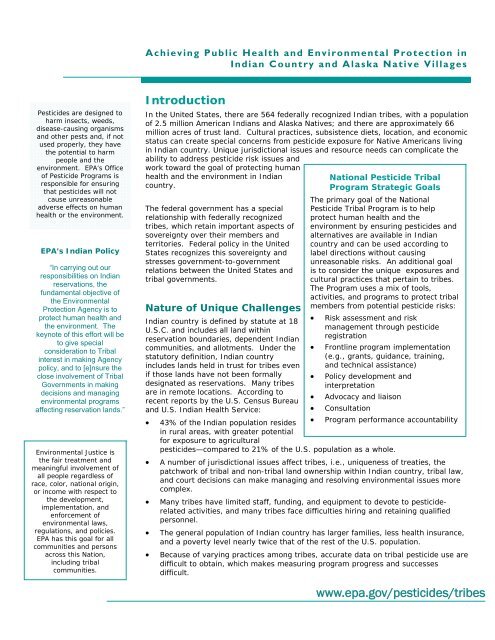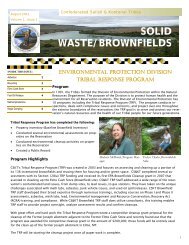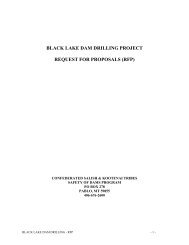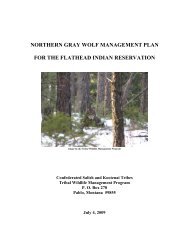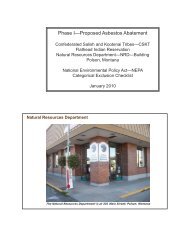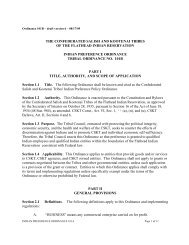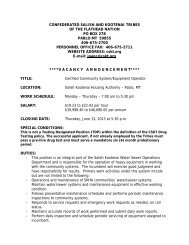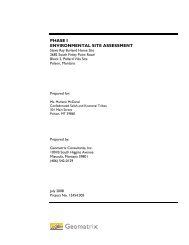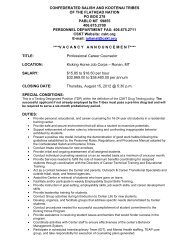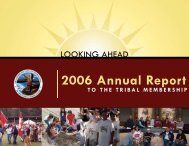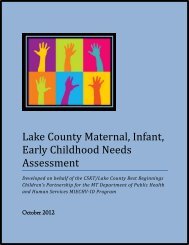US EPA - The National Pesticide Tribal Program - US Environmental ...
US EPA - The National Pesticide Tribal Program - US Environmental ...
US EPA - The National Pesticide Tribal Program - US Environmental ...
Create successful ePaper yourself
Turn your PDF publications into a flip-book with our unique Google optimized e-Paper software.
Achieving Public Health and <strong>Environmental</strong> Protection in<br />
Indian Country and Alaska Native Villages<br />
<strong>Pesticide</strong>s are designed to<br />
harm insects, weeds,<br />
disease-causing organisms<br />
and other pests and, if not<br />
used properly, they have<br />
the potential to harm<br />
people and the<br />
environment. <strong>EPA</strong>’s Office<br />
of <strong>Pesticide</strong> <strong>Program</strong>s is<br />
responsible for ensuring<br />
that pesticides will not<br />
cause unreasonable<br />
adverse effects on human<br />
health or the environment.<br />
<strong>EPA</strong>’s Indian Policy<br />
“In carrying out our<br />
responsibilities on Indian<br />
reservations, the<br />
fundamental objective of<br />
the <strong>Environmental</strong><br />
Protection Agency is to<br />
protect human health and<br />
the environment. <strong>The</strong><br />
keynote of this effort will be<br />
to give special<br />
consideration to <strong>Tribal</strong><br />
interest in making Agency<br />
policy, and to [e]nsure the<br />
close involvement of <strong>Tribal</strong><br />
Governments in making<br />
decisions and managing<br />
environmental programs<br />
affecting reservation lands.”<br />
<strong>Environmental</strong> Justice is<br />
the fair treatment and<br />
meaningful involvement of<br />
all people regardless of<br />
race, color, national origin,<br />
or income with respect to<br />
the development,<br />
implementation, and<br />
enforcement of<br />
environmental laws,<br />
regulations, and policies.<br />
<strong>EPA</strong> has this goal for all<br />
communities and persons<br />
across this Nation,<br />
including tribal<br />
communities.<br />
Introduction<br />
In the United States, there are 564 federally recognized Indian tribes, with a population<br />
of 2.5 million American Indians and Alaska Natives; and there are approximately 66<br />
million acres of trust land. Cultural practices, subsistence diets, location, and economic<br />
status can create special concerns from pesticide exposure for Native Americans living<br />
in Indian country. Unique jurisdictional issues and resource needs can complicate the<br />
ability to address pesticide risk issues and<br />
work toward the goal of protecting human<br />
health and the environment in Indian<br />
<strong>National</strong> <strong>Pesticide</strong> <strong>Tribal</strong><br />
country.<br />
<strong>Program</strong> Strategic Goals<br />
<strong>The</strong> primary goal of the <strong>National</strong><br />
<strong>The</strong> federal government has a special <strong>Pesticide</strong> <strong>Tribal</strong> <strong>Program</strong> is to help<br />
relationship with federally recognized protect human health and the<br />
tribes, which retain important aspects of environment by ensuring pesticides and<br />
sovereignty over their members and alternatives are available in Indian<br />
territories. Federal policy in the United country and can be used according to<br />
States recognizes this sovereignty and label directions without causing<br />
stresses government-to-government unreasonable risks. An additional goal<br />
relations between the United States and<br />
tribal governments.<br />
Nature of Unique Challenges<br />
is to consider the unique exposures and<br />
cultural practices that pertain to tribes.<br />
<strong>The</strong> <strong>Program</strong> uses a mix of tools,<br />
activities, and programs to protect tribal<br />
members from potential pesticide risks:<br />
Indian country is defined by statute at 18<br />
• Risk assessment and risk<br />
U.S.C. and includes all land within<br />
management through pesticide<br />
reservation boundaries, dependent Indian<br />
registration<br />
communities, and allotments. Under the • Frontline program implementation<br />
statutory definition, Indian country<br />
(e.g., grants, guidance, training,<br />
includes lands held in trust for tribes even and technical assistance)<br />
if those lands have not been formally • Policy development and<br />
designated as reservations. Many tribes interpretation<br />
are in remote locations. According to<br />
• Advocacy and liaison<br />
recent reports by the U.S. Census Bureau<br />
and U.S. Indian Health Service: • Consultation<br />
• 43% of the Indian population resides<br />
in rural areas, with greater potential<br />
for exposure to agricultural<br />
• <strong>Program</strong> performance accountability<br />
pesticides—compared to 21% of the U.S. population as a whole.<br />
• A number of jurisdictional issues affect tribes, i.e., uniqueness of treaties, the<br />
patchwork of tribal and non-tribal land ownership within Indian country, tribal law,<br />
and court decisions can make managing and resolving environmental issues more<br />
complex.<br />
• Many tribes have limited staff, funding, and equipment to devote to pesticiderelated<br />
activities, and many tribes face difficulties hiring and retaining qualified<br />
personnel.<br />
• <strong>The</strong> general population of Indian country has larger families, less health insurance,<br />
and a poverty level nearly twice that of the rest of the U.S. population.<br />
• Because of varying practices among tribes, accurate data on tribal pesticide use are<br />
difficult to obtain, which makes measuring program progress and successes<br />
difficult.<br />
www.epa.gov/pesticides/tribes


